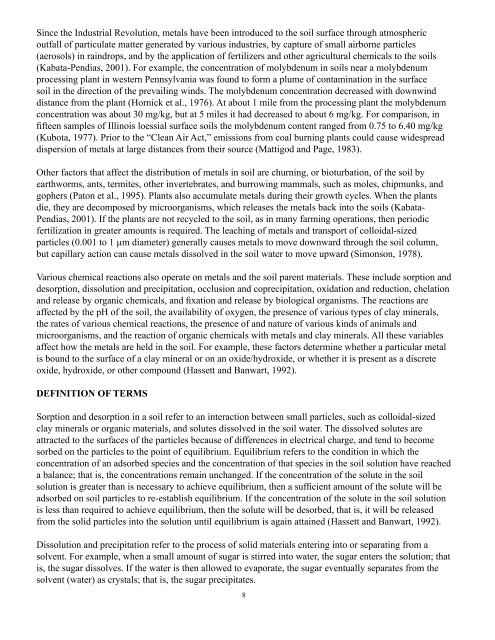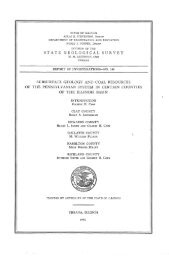Since the Industrial Revolution, metals have been introduced to the soil surface <strong>through</strong> <strong>at</strong>mosphericoutfall <strong>of</strong> particul<strong>at</strong>e m<strong>at</strong>ter gener<strong>at</strong>ed <strong>by</strong> various industries, <strong>by</strong> capture <strong>of</strong> small airborne particles(aerosols) in raindrops, and <strong>by</strong> the applic<strong>at</strong>ion <strong>of</strong> fertilizers and other agricultural chemicals to the soils(Kab<strong>at</strong>a-Pendias, 2001). For example, the concentr<strong>at</strong>ion <strong>of</strong> molybdenum in soils near a molybdenumprocessing plant in western Pennsylvania was found to form a plume <strong>of</strong> contamin<strong>at</strong>ion in the surfacesoil in the direction <strong>of</strong> the prevailing winds. The molybdenum concentr<strong>at</strong>ion decreased with downwinddistance from the plant (Hornick et al., 1976). At about 1 mile from the processing plant the molybdenumconcentr<strong>at</strong>ion was about 30 mg/kg, but <strong>at</strong> 5 miles it had decreased to about 6 mg/kg. For comparison, infifteen samples <strong>of</strong> <strong>Illinois</strong> loessial surface soils the molybdenum content ranged from 0.75 to 6.40 mg/kg(Kubota, 1977). Prior to the “Clean Air Act,” emissions from coal burning plants could cause widespreaddispersion <strong>of</strong> metals <strong>at</strong> large distances from their source (M<strong>at</strong>tigod and Page, 1983).Other factors th<strong>at</strong> affect the distribution <strong>of</strong> metals in soil are churning, or bioturb<strong>at</strong>ion, <strong>of</strong> the soil <strong>by</strong>earthworms, ants, termites, other invertebr<strong>at</strong>es, and burrowing mammals, such as moles, chipmunks, andgophers (P<strong>at</strong>on et al., 1995). Plants also accumul<strong>at</strong>e metals during their growth cycles. When the plantsdie, they are decomposed <strong>by</strong> microorganisms, which releases the metals back into the soils (Kab<strong>at</strong>a-Pendias, 2001). If the plants are not recycled to the soil, as in many farming oper<strong>at</strong>ions, then periodicfertiliz<strong>at</strong>ion in gre<strong>at</strong>er amounts is required. The leaching <strong>of</strong> metals and transport <strong>of</strong> colloidal-sizedparticles (0.001 to 1 µm diameter) generally causes metals to move downward <strong>through</strong> the soil column,but capillary action can cause metals dissolved in the soil w<strong>at</strong>er to move upward (Simonson, 1978).Various chemical reactions also oper<strong>at</strong>e on metals and the soil parent m<strong>at</strong>erials. These include sorption anddesorption, dissolution and precipit<strong>at</strong>ion, occlusion and coprecipit<strong>at</strong>ion, oxid<strong>at</strong>ion and reduction, chel<strong>at</strong>ionand release <strong>by</strong> organic chemicals, and fix<strong>at</strong>ion and release <strong>by</strong> biological organisms. The reactions areaffected <strong>by</strong> the pH <strong>of</strong> the soil, the availability <strong>of</strong> oxygen, the presence <strong>of</strong> various types <strong>of</strong> clay minerals,the r<strong>at</strong>es <strong>of</strong> various chemical reactions, the presence <strong>of</strong> and n<strong>at</strong>ure <strong>of</strong> various kinds <strong>of</strong> animals andmicroorganisms, and the reaction <strong>of</strong> organic chemicals with metals and clay minerals. All these variablesaffect how the metals are held in the soil. For example, these factors determine whether a particular metalis bound to the surface <strong>of</strong> a clay mineral or on an oxide/hydroxide, or whether it is present as a discreteoxide, hydroxide, or other compound (Hassett and Banwart, 1992).DEFINITION OF TERMSSorption and desorption in a soil refer to an interaction between small particles, such as colloidal-sizedclay minerals or organic m<strong>at</strong>erials, and solutes dissolved in the soil w<strong>at</strong>er. The dissolved solutes are<strong>at</strong>tracted to the surfaces <strong>of</strong> the particles because <strong>of</strong> differences in electrical charge, and tend to becomesorbed on the particles to the point <strong>of</strong> equilibrium. Equilibrium refers to the condition in which theconcentr<strong>at</strong>ion <strong>of</strong> an adsorbed species and the concentr<strong>at</strong>ion <strong>of</strong> th<strong>at</strong> species in the soil solution have reacheda balance; th<strong>at</strong> is, the concentr<strong>at</strong>ions remain unchanged. If the concentr<strong>at</strong>ion <strong>of</strong> the solute in the soilsolution is gre<strong>at</strong>er than is necessary to achieve equilibrium, then a sufficient amount <strong>of</strong> the solute will beadsorbed on soil particles to re-establish equilibrium. If the concentr<strong>at</strong>ion <strong>of</strong> the solute in the soil solutionis less than required to achieve equilibrium, then the solute will be desorbed, th<strong>at</strong> is, it will be releasedfrom the solid particles into the solution until equilibrium is again <strong>at</strong>tained (Hassett and Banwart, 1992).Dissolution and precipit<strong>at</strong>ion refer to the process <strong>of</strong> solid m<strong>at</strong>erials entering into or separ<strong>at</strong>ing from asolvent. For example, when a small amount <strong>of</strong> sugar is stirred into w<strong>at</strong>er, the sugar enters the solution; th<strong>at</strong>is, the sugar dissolves. If the w<strong>at</strong>er is then allowed to evapor<strong>at</strong>e, the sugar eventually separ<strong>at</strong>es from thesolvent (w<strong>at</strong>er) as crystals; th<strong>at</strong> is, the sugar precipit<strong>at</strong>es.8
Occlusion refers to the physical enclosure or capture <strong>of</strong> small amounts <strong>of</strong> fluid, such as soil solution, in arapidly growing crystal. Coprecipit<strong>at</strong>ion refers to the precipit<strong>at</strong>ion <strong>of</strong> a substance th<strong>at</strong> would otherwise besoluble along with an insoluble precipit<strong>at</strong>e (Fisher, 1961).Oxid<strong>at</strong>ion and reduction refer to the transfer <strong>of</strong> one or more electrons between ions in solution. Bydefinition, the ion, or electrically charged <strong>at</strong>om, from which the electron is transferred is oxidized, and theion which receives the electron is reduced. In soils, iron and manganese commonly undergo oxid<strong>at</strong>ionreductionreactions. Under oxidizing conditions, the soil generally is well-drained and aer<strong>at</strong>ed, and bothiron and manganese precipit<strong>at</strong>e, commonly as oxides and/or hydroxides (called oxyhydroxides). If thesoil becomes s<strong>at</strong>ur<strong>at</strong>ed with w<strong>at</strong>er and oxygen is excluded (producing reducing conditions), iron andmanganese oxides and hydroxides dissolve. In the overall process the iron and manganese gain electronsduring reduction and lose electrons during oxid<strong>at</strong>ion (Birkeland, 1999).As plant residues decompose, many organic compounds are formed, some <strong>of</strong> which will dissolve in thesoil solution. Metals, such as cobalt, nickel, iron, and manganese, are readily captured <strong>by</strong> the organicmolecules to form wh<strong>at</strong> are known as chel<strong>at</strong>e compounds (Fritz and Schenk, 1966). Microorganismssometimes accumul<strong>at</strong>e metal ions, effectively removing the ions from the soil solution. However, whenthe microorganism dies and decomposes, the accumul<strong>at</strong>ed ions will be released again (We<strong>at</strong>herley et al.,1980).The reactions described above can all occur <strong>at</strong> the same time in a soil. Several factors govern the reactions.These factors include: (1) temper<strong>at</strong>ure, (2) pH, (3) the depth to which oxygen can penetr<strong>at</strong>e the soilcolumn and the r<strong>at</strong>e <strong>at</strong> which it can be replaced as it is used in chemical and biological reactions, (4) thedegree <strong>of</strong> s<strong>at</strong>ur<strong>at</strong>ion <strong>of</strong> the soil <strong>by</strong> w<strong>at</strong>er, and (5) the number and types <strong>of</strong> animals and microorganisms inthe soil. The various chemical and biological reactions determine how metals are held in the soil.FIELD METHODSThe sampling plan we adopted was to collect cores <strong>of</strong> soils <strong>at</strong> the points <strong>of</strong> intersection, or nodes, <strong>of</strong> arectangular grid, 20 miles on a side, laid on top <strong>of</strong> a st<strong>at</strong>e map. The grid was established in the UniversalTransverse Merc<strong>at</strong>or projection <strong>by</strong> drawing the first node ten miles west <strong>of</strong> Lake Michigan and 10 milessouth <strong>of</strong> the <strong>Illinois</strong>-Wisconsin border, in Lake County, northeastern <strong>Illinois</strong>. The remainder <strong>of</strong> the gridwas drawn from this starting point using Geographic Inform<strong>at</strong>ion System (GIS) computer s<strong>of</strong>tware. Thegrid comprises 137 nodes which we selected as sampling sites (see Figure 5).The loc<strong>at</strong>ions <strong>of</strong> the grid nodes calcul<strong>at</strong>ed <strong>by</strong> the GIS were used to loc<strong>at</strong>e the target sampling points onappropri<strong>at</strong>e topographic maps, pl<strong>at</strong> maps, soil maps, and highway maps. County assessment supervisorsor county clerks were contacted to confirm the current ownership <strong>of</strong> the various properties upon whichthe grid nodes were loc<strong>at</strong>ed. Landowners were then contacted <strong>by</strong> letter to inform them <strong>of</strong> the researchproject and to inform them th<strong>at</strong> ISGS personnel would like to visit with them to discuss the project andtheir willingness to particip<strong>at</strong>e <strong>by</strong> granting permission for a core to be taken from their property. Mostlandowners we contacted in 1998 were willing to particip<strong>at</strong>e. For the few who did not wish to particip<strong>at</strong>e,an altern<strong>at</strong>e site was selected from a near<strong>by</strong> loc<strong>at</strong>ion which had the same soil type as th<strong>at</strong> <strong>at</strong> the originaltarget sampling loc<strong>at</strong>ion.The initial visits with landowners were made during September 1998. <strong>Cores</strong> were collected <strong>at</strong> <strong>26</strong> loc<strong>at</strong>ionsduring November and December 1998, after harvest was completed. The gray circular symbols on the map9
- Page 1 and 2: A Progress Report on the Descriptio
- Page 3 and 4: INTRODUCTIONThe Illinois State Geol
- Page 5 and 6: As continental glaciers advanced in
- Page 7 and 8: In areas where the glacial sediment
- Page 9: the boundary between them. Where su
- Page 13 and 14: tungsten carbide grinding capsule t
- Page 15 and 16: RESULTS AND DISCUSSIONSampling Plan
- Page 17 and 18: increases also. If the correlation
- Page 19 and 20: CO 2 gas= CO 2 aqCO 2 aq+ H 2O = H
- Page 21 and 22: Potassium Typically, potassium occu
- Page 23 and 24: on oxides and hydroxides. Fertilize
- Page 25 and 26: For most cores, the Rb content was
- Page 27 and 28: Brady, N. C. and R. R. Weil, 1999,
- Page 29 and 30: Killey, M. M., 1998, Illinois’ Ic
- Page 31 and 32: Table 1. Core number, county name,
- Page 33 and 34: Table 3. Texture of samples from co
- Page 35 and 36: Table 9. Texture of samples from co
- Page 37 and 38: Table 15. Texture of samples from c
- Page 39 and 40: Table 19. Soil texture, soil type,
- Page 41 and 42: Table 20 continued. Correlation coe
- Page 43 and 44: Table 21. Elemental composition of
- Page 45 and 46: Table 23. Elemental composition of
- Page 47 and 48: Table 25. Elemental composition of
- Page 49 and 50: Table 27. Elemental composition of
- Page 51 and 52: Table 29. Elemental composition of
- Page 53 and 54: Table 31. Elemental composition of
- Page 55 and 56: Table 33. Elemental composition of
- Page 57 and 58: Table 35. Elemental composition of
- Page 59 and 60: Table 37. Means and ranges of eleme
- Page 61 and 62:
Sample locationFigure 2 Sample loca
- Page 63 and 64:
Figure 461
- Page 65 and 66:
Figure 6.63
- Page 67 and 68:
Figure 8.65
- Page 69 and 70:
Figure 10.67
- Page 71 and 72:
Figure 12.69
- Page 73 and 74:
Figure 14.71
- Page 75 and 76:
Figure 16.73
- Page 77 and 78:
Figure 18.75
- Page 79 and 80:
Figure 20.77
- Page 81 and 82:
Figure 22.79
- Page 83 and 84:
Figure 24.81
- Page 85 and 86:
Figure 26.83
- Page 87 and 88:
Figure 28.85
- Page 89 and 90:
Figure 31.87
- Page 91 and 92:
Figure 33.89
- Page 93 and 94:
Figure 35.91
- Page 95:
Figure 37.93
















